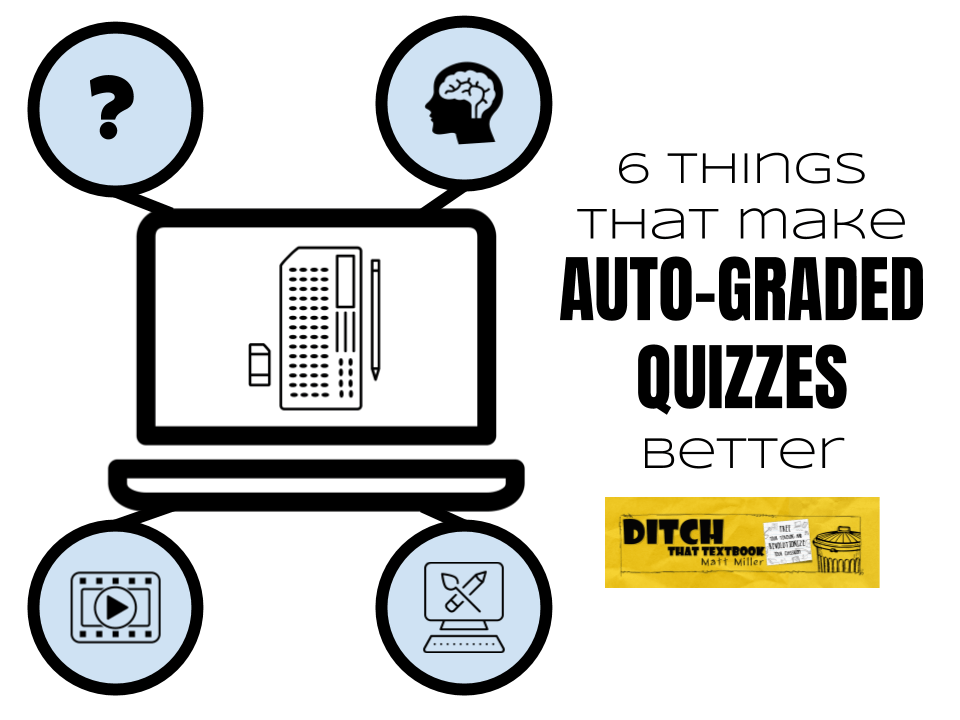

Auto-graded quizzes have their pro’s and con’s. They cut back on teacher grading time and provide students with quick feedback. But they don’t show what students can do with what they’re learned and limit 21st century skills (communication, collaboration, creativity, critical thinking).
Should we use auto-graded quizzes? That’s a question I wrestled with in this blog post. Feel free to check it out first.
Let’s say we’re going to use them. Auto-graded. Multiple-choice.
Can we make them better?
Can we keep the pro’s — fast grading and feedback — and improve on the con’s?
I think the answer is “yes.” If you’re intent on an auto-graded quiz, what if you added something to it? Maybe as part of the quiz/test grade or as an additional grade?
Here are some ideas to try …
It’s hard to see inside a student’s brain with a multiple-choice question. It’s also hard to know if a student understood the question and understood the possible answers. A lot can go wrong here.

Students can explain their thinking in videos with tools like Flipgrid. (Screenshot: flipgrid.com)
Give students one deep dive question where they can describe their thinking. Show what they have learned. Give you a glimpse into their problem-solving process.
Students can pick one question from the test or you can choose it for them.
Incorporate digital tools to enhance it:
Sometimes, we don’t know that one of our questions is worded poorly until it’s too late.
Maybe, one of our questions is worded well but a student just misunderstood it.
It’s a shame when a student has learned but it isn’t reflected in an assessment.
Offer a text box at the end of an auto-graded quiz (like Google Forms). Or, if it doesn’t have that feature, let students use a piece of paper or a document to describe their thinking. They can do it for any question where they’re unsure what they question is asking — or when they want to make sure you know what they have learned.
This lets students volunteer all that they’ve learned to make sure they get credit for it. Everyone benefits.
“What you’ve learned isn’t as important as what you can do with it.”

An example infographic created with Google Drawings.
The world seems to be moving more and more in this direction. Encourage students to show what they know by creating something out of it.
Some ideas:
When you add this to the end of an auto-graded quiz, it focuses on two things: the facts you remembered AND how you can apply those facts.
Graphic organizers guide your students’ thinking and make it visible. After an auto-graded quiz, they can fill out an appropriate graphic organizer to show what they’ve learned in a less black-and-white, right-or-wrong manner.
Example: The Frayer model. In a Frayer graphic organizer about a vocabulary word, a student can write his/her definition, characteristics, examples and non-examples. This empowers the student to show what he/she knows. It avoids the “gotcha” game when a quiz asks a question he/she can’t answer.
You can find dozens of free downloadable, “file – make a copy” graphic organizers by clicking here.
Sometimes, we can see how much our students have learned by letting them ask questions rather than answer them. This is the strength of Question Formulation Technique (QFT).
QFT, developed by the Right Question Institute, combines three thinking abilities in one process: divergent thinking, convergent thinking, and metacognitive thinking.
Its process is simple, including: design a focus, introduce rules, produce questions, improve questions, prioritize questions, discuss next steps, and reflect.
The whole process that you can use in your class can be found here.
Taking time to reflect on learning helps us internalize it for the future. However, it’s a step that we all-too-often leave out. We’re off to the next lesson, unit, topic of study.
Improve on auto-graded multiple choice quizzes by including some non-graded metacognitive questions at the end. In the book Don’t Ditch That Tech: Differentiated Instruction for a Digital World, my co-author Angie Ridgway shared these example metacognitive questions you can use:
For younger students:
For older students:
You don’t have to ditch those auto-graded quizzes! However, as you add one or more of these activities to those quizzes, you may find students get tons of value from them. It may shape the way you create assessments in the future!
For notifications of new Ditch That Textbook content and helpful links:
Interested in having Matt present at your event or school? Contact him by e-mail!
Matt is scheduled to present at the following upcoming events:
[getnoticed-event-table scope=”upcoming” max=”15″ expanding=”false”]

Session expired
Please log in again. The login page will open in a new tab. After logging in you can close it and return to this page.